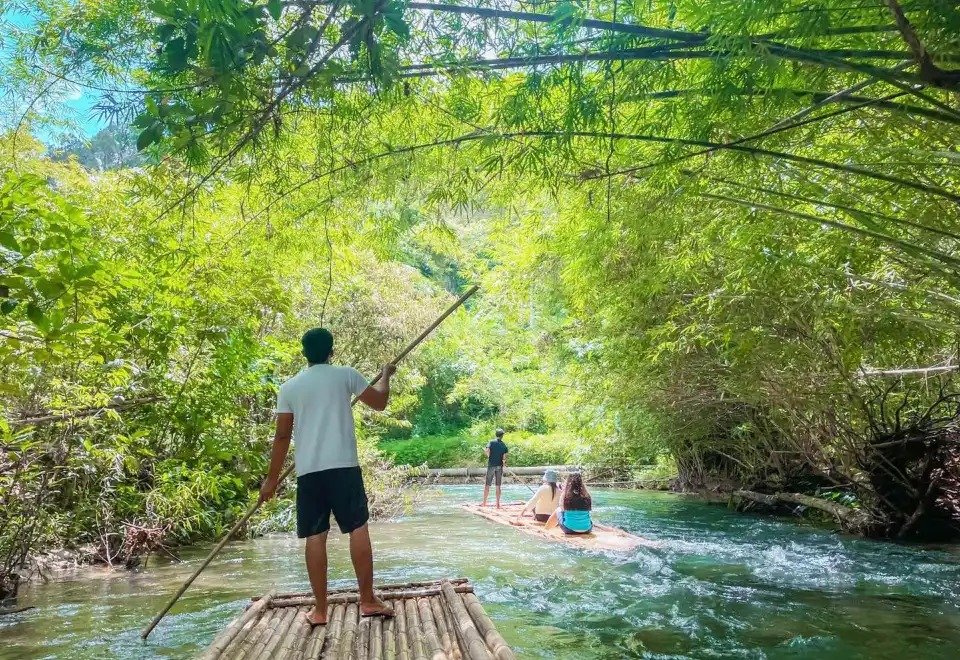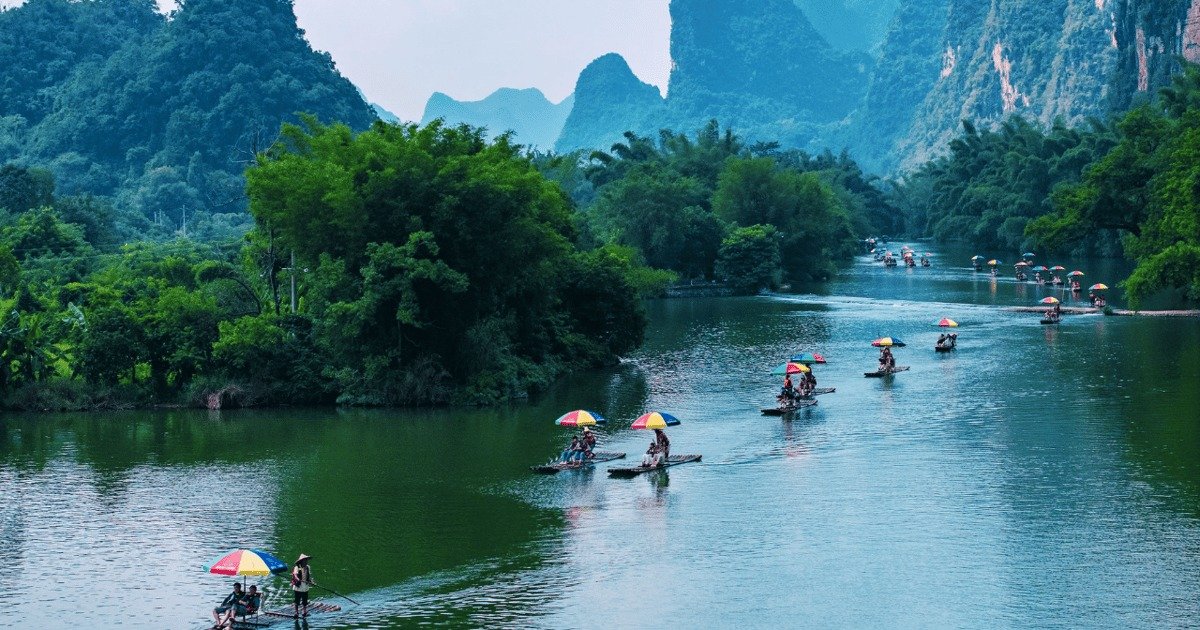Bamboo river rafting is more than just an outdoor activity—it’s an immersive cultural journey. Unlike modern white-water rafting, bamboo rafting is a slow, serene ride on handcrafted rafts, offering a unique way to explore lush landscapes and tranquil waterways. This eco-friendly adventure invites travelers to appreciate nature while connecting with centuries-old traditions.
Whether you are seeking an adrenaline-filled trip or a peaceful cruise through tropical rivers, bamboo river rafting blends both worlds. With its deep cultural roots and sustainable practices, this activity has become a must-do for eco-conscious adventurers and families alike.
Discover the best tours in Thailand at exclusive prices with thai adventure club
The History of Bamboo River Rafting
The origins of bamboo river rafting can be traced back to ancient rural communities, where locals used bamboo rafts to transport goods, fish, and people across rivers. Over time, these practical vessels evolved into tourist attractions, allowing travelers to explore untouched landscapes.
Bamboo river rafting is also tied to traditional craftsmanship. Locals take pride in constructing these rafts by hand, using techniques passed down through generations. This activity has transformed into an eco-tourism experience that showcases cultural heritage while offering sustainable travel opportunities for nature enthusiasts.
Why Bamboo River Rafting Is the Perfect Eco-Friendly Choice
Sustainability is a key reason travelers choose bamboo river rafting. Unlike motorized boats, bamboo rafts rely on natural materials and human skill, creating a zero-pollution travel experience. They are biodegradable and built without harming the environment, making rafting a symbol of eco-friendly adventure tourism.
This practice also supports rural communities by offering locals sustainable jobs in guiding tours and building rafts. For eco-conscious travelers, bamboo river rafting is not just an activity; it’s a meaningful way to support cultural preservation and environmental protection while enjoying breathtaking scenery.
Top Destinations for Bamboo River Rafting
Travelers seeking authentic experiences often wonder where to try bamboo river rafting. Below are some of the best destinations offering scenic river cruises and cultural immersion:
- Thailand: Known for iconic rafting spots like Khao Lak, Chiang Mai, and Phang Nga.
- Vietnam: Offers tropical landscapes and relaxing river journeys.
- China: Home to traditional rafting experiences in Guilin.
- Indonesia: Combines lush rainforest scenery with cultural exploration.
- Sri Lanka: Popular for its serene eco-tourism activities.
These locations combine natural beauty and cultural richness, making them perfect for travelers looking for guided rafting experiences.

What to Expect During a Bamboo River Rafting Tour
A bamboo river rafting tour is a calm, scenic ride rather than an intense sport. Passengers sit on bamboo platforms while a skilled local guide uses a bamboo pole to steer the raft. This slow pace allows travelers to absorb the surrounding landscapes, from tropical rivers to lush forests.
Travelers often ask, “Is bamboo river rafting safe?” The answer is yes—it’s suitable for families and even non-swimmers. Wearing light, comfortable clothing is recommended. By understanding what to expect, you can enjoy the journey with peace of mind, knowing you’re in safe hands.
The Experience: Adventure Meets Culture
Bamboo river rafting offers more than a scenic journey; it immerses travelers in local traditions. Rafting guides often share stories about their culture, environment, and lifestyle, giving visitors a deeper appreciation of the region.
This activity bridges adventure tourism with authentic cultural experiences. Travelers not only enjoy the thrill of outdoor exploration but also witness rural life up close. From spotting wildlife to learning about bamboo craftsmanship, rafting provides a holistic view of both nature and heritage.
Highlights of Bamboo Rafting Tours
To help travelers better understand the value of this activity, here are the key highlights of a bamboo river rafting tour:
- Cultural river journeys: Experience life in local river communities.
- Tropical river scenery: Glide past lush forests and wildlife habitats.
- Handmade bamboo rafts: Learn about sustainable, traditional construction methods.
- Adventure activities in Asia: A perfect mix of exploration and relaxation.
- Guided rafting experiences: Gain insight from expert local guides.
These highlights showcase why bamboo rafting is not just an activity, but a memorable experience.
Tips for Booking the Best Bamboo Rafting Tour
Booking a bamboo river rafting tour is simple, but knowing the right steps ensures a smooth trip:
- Research reputable eco-tour companies with strong sustainability practices.
- Check seasonal weather conditions for the best river levels.
- Opt for guided rafting experiences to enhance safety and learning.
- Book in advance during peak tourist seasons to secure spots.
- Look for packages that include cultural stops, meals, or local crafts.
These tips help travelers make informed choices, guaranteeing a rewarding adventure that’s both safe and authentic.
Bamboo River Rafting for Families and Groups
One of the best features of bamboo river rafting is its suitability for families and group travelers. The calm nature of bamboo rafting makes it a great bonding activity, especially for those who prefer slower-paced adventures.
Many tour operators offer family-friendly packages that include additional activities like hiking, local cuisine tasting, or cultural workshops. For groups, rafting is a social experience, allowing everyone to enjoy nature together while sharing stories along the ride.
Why Bamboo River Rafting is a Must-Do for Eco-Travelers
If you’re looking for a travel experience that blends sustainability, culture, and adventure, bamboo river rafting is an ideal choice. Unlike conventional tours, bamboo rafting doesn’t disrupt natural ecosystems, making it a responsible activity for environmentally conscious travelers.
By choosing bamboo rafting, you support local artisans, guides, and communities. This cultural connection makes the activity much more than a river ride—it’s an exchange of traditions and stories that leave a lasting impression.
Frequently Asked Questions About Bamboo River Rafting
Here are some common questions travelers ask before embarking on their bamboo river rafting journey:
- Is bamboo river rafting safe for children?
Yes, bamboo rafting is calm and family-friendly, making it suitable for kids. - What should I wear for bamboo rafting?
Lightweight, breathable clothes and sandals are recommended. Bring sunscreen and a hat for sun protection. - Do I need swimming experience?
No. Rafts are stable, and life jackets are provided. - Where is the best place to try bamboo rafting?
Thailand, Vietnam, and Indonesia are top destinations. - Is bamboo rafting eco-friendly?
Absolutely. Rafts are handmade from biodegradable materials, promoting sustainable tourism.
The Cultural Significance of Bamboo Rafting
Beyond being an adventure activity, bamboo river rafting holds cultural importance. Bamboo is deeply rooted in Asian traditions, symbolizing resilience, flexibility, and harmony with nature. By participating in rafting tours, travelers engage in a centuries-old tradition that reflects the local way of life.
Local artisans craft each raft by hand, using techniques that have been passed down for generations. This makes every ride unique and meaningful, as visitors get to appreciate both the artistry and the cultural depth behind bamboo rafting.
Combining Bamboo Rafting with Other Activities
For those seeking a full travel itinerary, bamboo river rafting can be combined with other cultural and adventure activities:
- Village tours to learn about local lifestyles.
- Cooking classes featuring regional cuisine.
- Wildlife spotting and photography excursions.
- Hiking through lush rainforests near riverbanks.
- Visits to bamboo workshops to see raft-making in action.
This mix of experiences adds value to your trip, making rafting part of a holistic cultural adventure.
Preparing for Your First Bamboo Rafting Trip
If it’s your first time trying bamboo river rafting, preparation is key:
- Book your trip with a certified eco-tour company.
- Wear quick-dry clothes and carry a waterproof bag.
- Apply insect repellent and sunscreen before boarding.
- Bring cash for tipping guides and buying local crafts.
- Stay hydrated, especially in tropical climates.
With these preparations, your first rafting trip will be comfortable, enjoyable, and stress-free.
A Unique Way to Connect with Nature
One of the greatest benefits of bamboo river rafting is its ability to help travelers disconnect from modern chaos and reconnect with nature. The slow pace of the raft encourages mindfulness, allowing you to observe wildlife, listen to birdsong, and feel the gentle flow of water beneath you.
This form of travel offers more than just sightseeing—it provides an opportunity for inner peace. Bamboo rafting proves that adventure doesn’t always mean speed and adrenaline; sometimes, it’s about slowing down and savoring every moment.
In a world where many travel experiences are becoming commercialized, bamboo river rafting stands out as a sustainable and culturally rich adventure. It blends eco-friendly tourism, traditional craftsmanship, and serene natural beauty, making it an unforgettable experience for all types of travelers.
Whether you’re a solo adventurer, a family seeking relaxation, or a group looking for something unique, bamboo rafting is a must-try activity. By choosing this experience, you’re not just exploring rivers—you’re preserving traditions, supporting local communities, and connecting with nature in a truly meaningful way.
Follow us on:
- Facebook: Thai Adventure Club
- Instagram: thaiadventureclub


Comment (0)